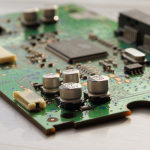Magnets in Everyday Items: Part 2 - Home Entertainment
Whether we realize it or not, we are surrounded by magnets. Last week, we looked at the uses of magnets in cleaning appliances such as vacuums, washing machines, and dryers. Now, we are shifting our focus to electronics and home entertainment. Keep reading to see the interesting ways these everyday items rely on the power of magnets to run efficiently.
Magnets in Computers
Computers are incredible devices that allow us to work, play, and study with ease. You may have assumed there were magnets in computers somewhere, but many are surprised to learn their main function is to help with storage. Inside each computer is a hard disk that contains all of your computer’s important files and information. This disk is comprised of tiny permanent magnets and metallic plates that generate the necessary code to produce your data.
Elsewhere, permanent magnets can be found inside of the fans that keep your device from overheating. The magnets and electrical components work together to put the fans in motion and keep things running smoothly. This concept also applies if your computer has a disc drive that allows you to insert CDs into your machine. If your computer has speakers, magnets are also hard at work within their shell. More on that below!
Magnets in Televisions
Magnets are also prevalent inside your television and computer monitors. These screens all contain cathode ray tubes, also known as CRTs, which send electrons to the screen to generate the images you see. This entire process is possible by, you guessed it, some hard-working electromagnets. While the magnets move inside the tube, they spread out the electrons multiple times per second to keep the video playing.
Magnets in Speakers
As mentioned above, speakers would not function without the magic of magnets. Speakers make sound through vibrations, which are possible due to electric signals. When the electric currents change, they produce a magnetic field. As this takes place, an opposing magnetic field creates more vibrations within the cone of the speaker. This field is what produces the sound you hear. Since speakers can vary in size, a larger magnet would be required to produce a more substantial sound.
Learn More About Magnets with Apex
Now that you have learned about the fascinating ways magnets work within electronics, why not learn even more about these powerful tools? Read about the many uses of magnets, take a look at DIY projects, and see how magnets help businesses thrive by reading some of our other blogs. You can also get the latest magnet news, exclusive discounts, and more sent directly to your inbox each month by signing up for our monthly newsletter.

